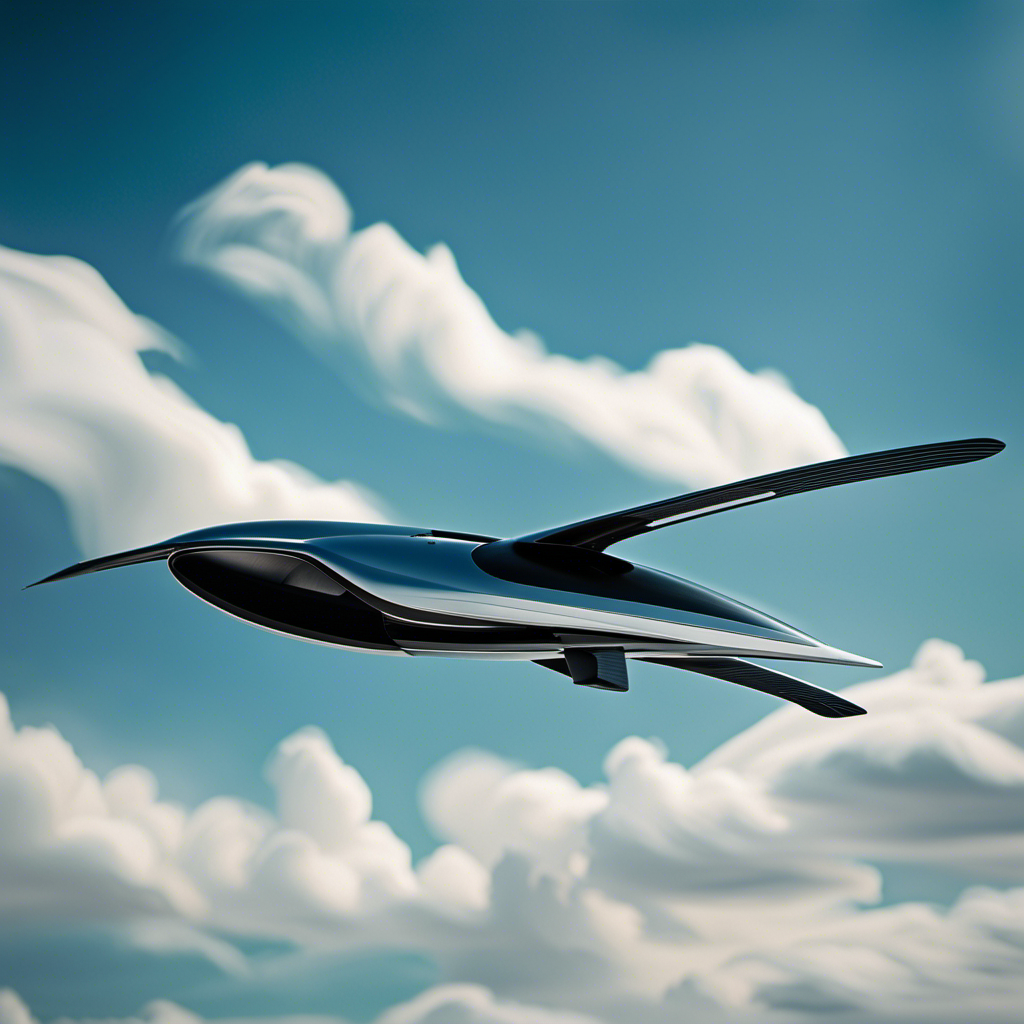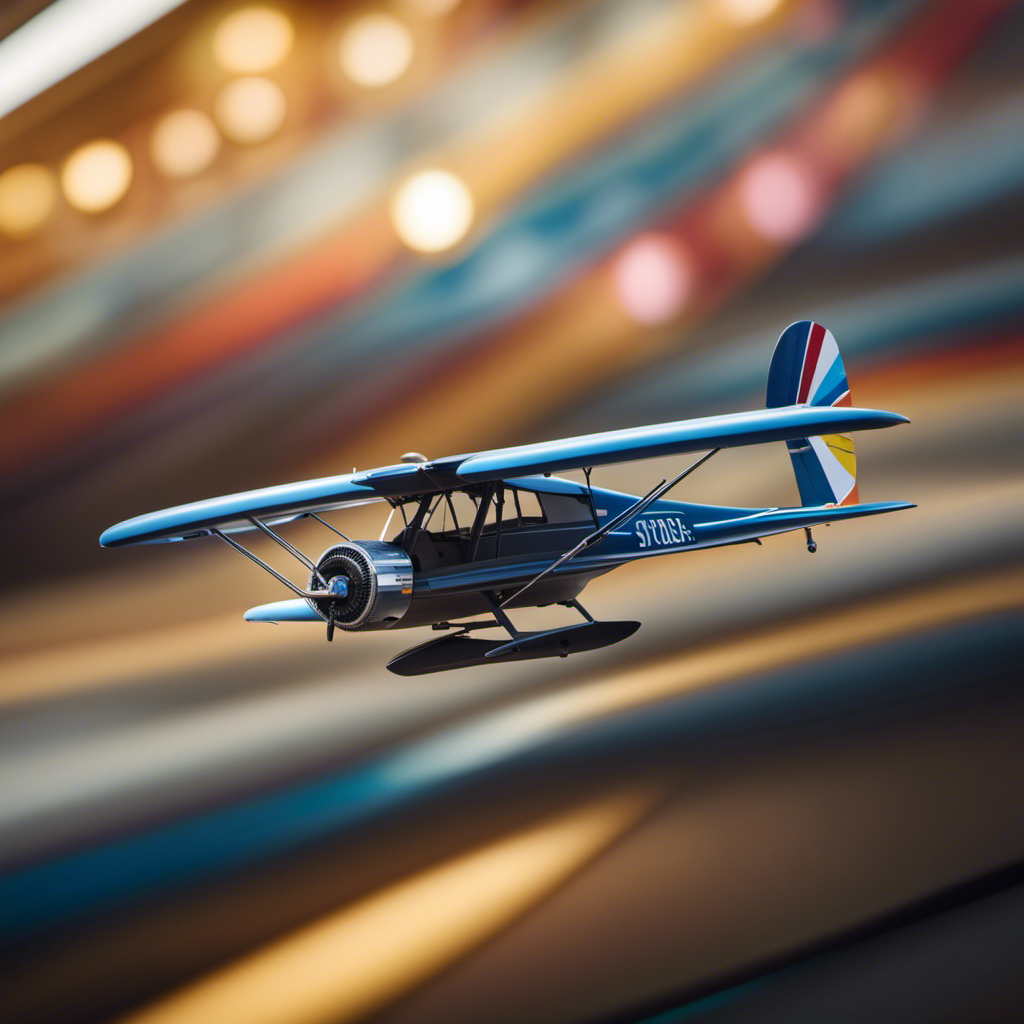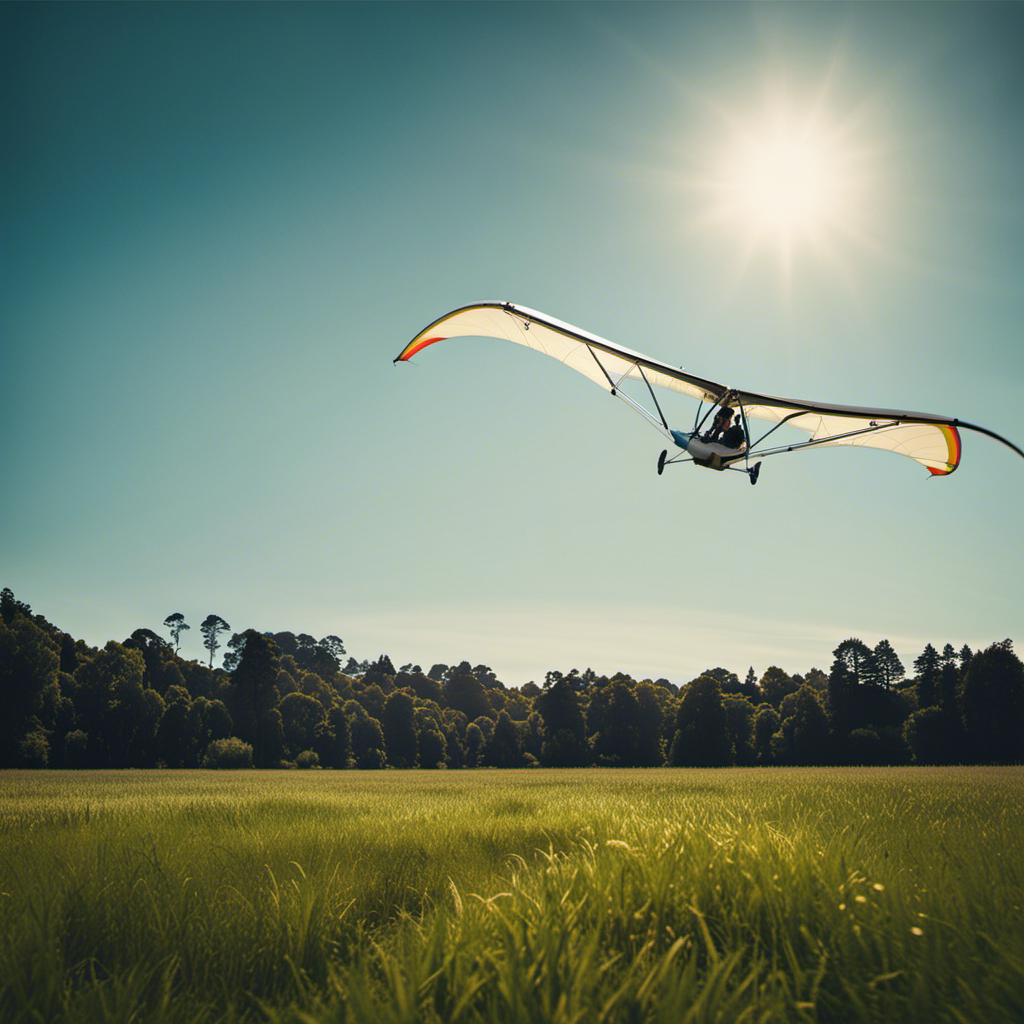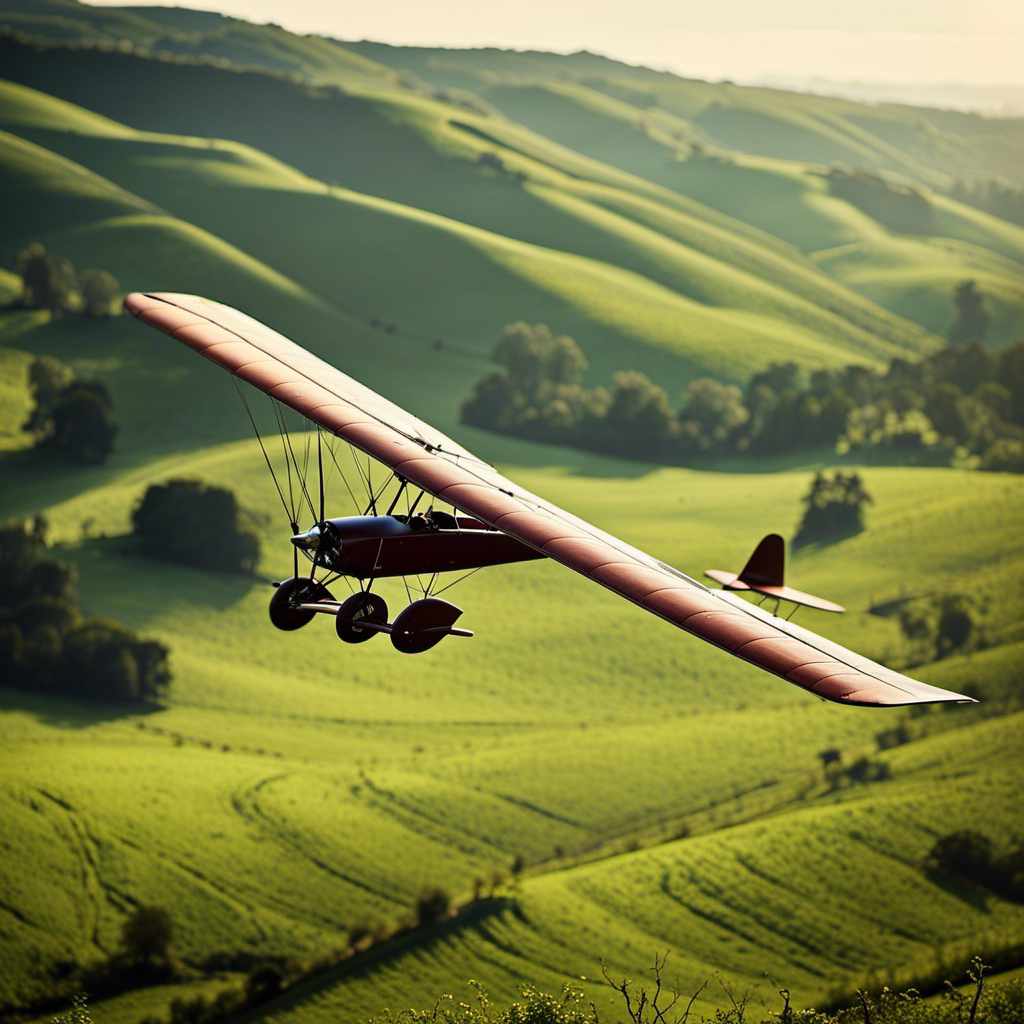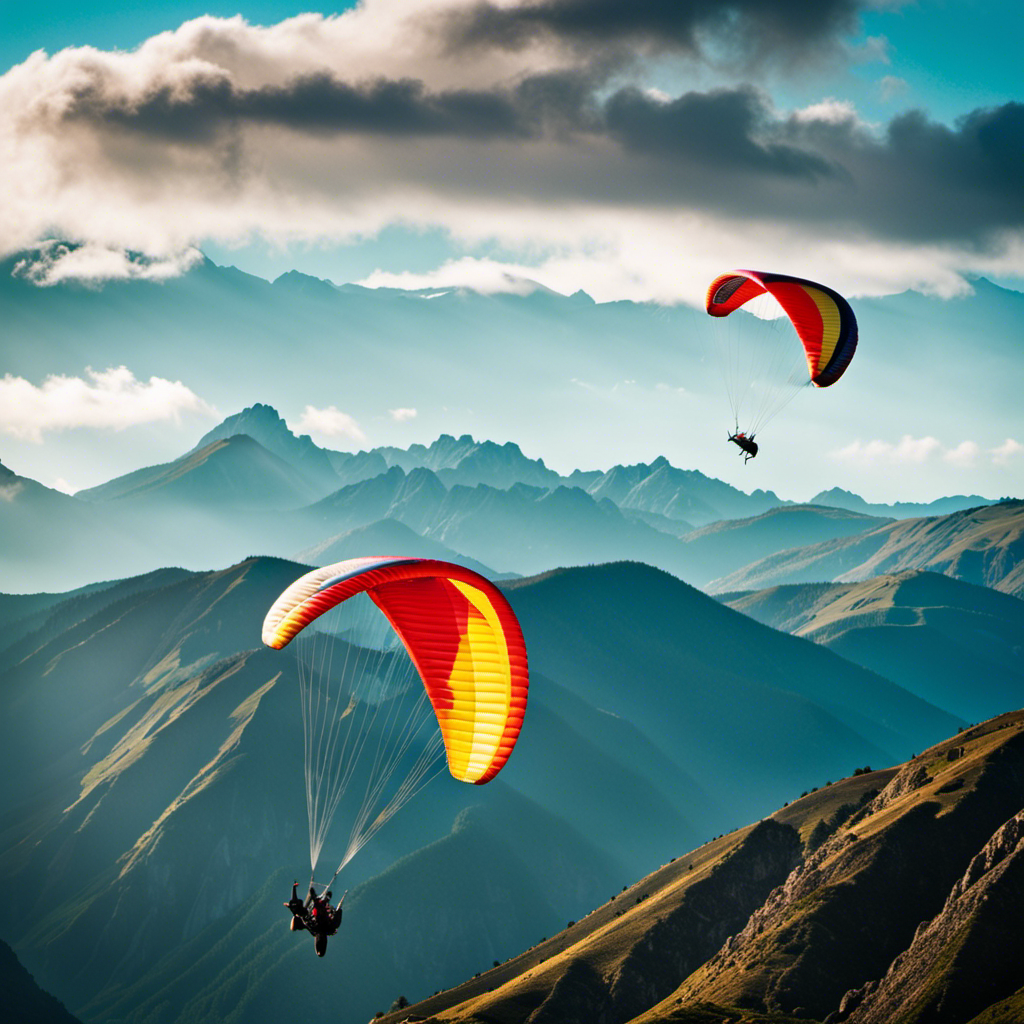As a fan of aviation, I am completely captivated by the marvels of glider aircraft. These incredible engineering achievements dominate the skies, skillfully harnessing natural forces to soar.
From their rich history to the intricate design principles that govern them, air glider planes are a testament to human ingenuity.
Join me on a journey as we explore the mechanics, techniques, and sheer thrill of glider flying. Prepare to be amazed by these soaring giants and discover the future possibilities they hold.
Key Takeaways
- Air glider planes have a rich history and have made significant contributions to aviation.
- Understanding the principles of lift and gravity is essential for glider flight.
- Air glider planes come in different types and features, including single-seat and two-seat gliders.
- Glider flight strategies and techniques involve exploiting thermals, ridge lift, and wave lift.
The History of Air Glider Planes
The history of air glider planes dates back to the early 19th century. These remarkable machines have played a crucial role in the development of aviation. Glider flight records and achievements throughout history have demonstrated the incredible capabilities of these aircraft.
Notable pioneers such as Otto Lilienthal and the Wright brothers made significant contributions to the advancement of glider technology. Lilienthal’s successful glider flights in the late 1800s paved the way for the Wright brothers’ first powered flight in 1903. Their achievements marked a turning point in aviation history, leading to the creation of powered airplanes.
The remarkable feats accomplished by early glider pilots laid the foundation for our understanding of aerodynamics and flight control. Understanding the history of air glider planes is essential to appreciate the engineering wonders that they are.
Transitioning into the subsequent section, let’s now explore how these incredible machines work.
How Air Glider Planes Work
As a pilot, I’ve always been fascinated by the principles of lift and gravity that govern the flight of glider planes. Understanding these principles is essential for mastering the art of glider flight.
Aerodynamics plays a crucial role in glider flight, and a deep understanding of the forces at play is necessary to control and maneuver these aircraft effectively.
The principles of lift and gravity
You can understand how lift and gravity work by examining the principles behind air glider planes.
Lift mechanics is crucial for the glider’s ability to stay aloft. It is achieved by the shape of the wings, called airfoils, which generate a pressure difference between the upper and lower surfaces. This pressure difference creates an upward force, countering the gravitational forces acting on the glider. The shape and angle of attack of the airfoil determine the amount of lift produced.
Gravity, on the other hand, is the force that pulls the glider downward. It is necessary to overcome gravity in order to maintain altitude and achieve controlled flight.
Understanding the interplay between lift and gravity is essential for comprehending the dynamics of glider flight and the principles of aerodynamics.
Understanding aerodynamics in glider flight
To understand aerodynamics in glider flight, it’s important to grasp the principles behind lift and gravity. Glider performance is heavily influenced by the impact of weather conditions. Here are two key factors to consider:
-
Wind: The direction and speed of wind greatly affect glider flight. A headwind can increase lift and allow the glider to stay in the air longer, while a tailwind can decrease lift and make it harder to maintain altitude.
-
Thermals: These are rising columns of warm air that can provide a glider with additional lift. By locating and utilizing thermals, pilots can extend their flight time and cover greater distances.
Understanding how weather conditions affect glider flight is crucial for optimizing performance and achieving longer flights.
Now, let’s delve into the fascinating world of different types of air glider planes.
Types of Air Glider Planes
When it comes to air glider planes, there are different types designed for specific purposes.
First, we have single-seat gliders that are ideal for solo flights, providing the pilot with complete control and freedom in the sky.
Then, there are two-seat gliders that are commonly used for training purposes and recreational flying, allowing for an instructor or a passenger to accompany the pilot.
Single-seat gliders for solo flights
If you’re looking for an exhilarating experience, try flying in a single-seat glider for a solo flight. These gliders are designed to be operated by a single pilot, providing a unique sense of freedom and control.
Before taking off, it is crucial to ensure that all safety equipment is in place. This includes a properly fitted helmet, a parachute, and a safety harness.
Weather conditions play a significant role in the success of a solo flight. It is essential to monitor the wind speed, direction, and turbulence levels before taking off. Additionally, pilots should be aware of any potential weather changes during the flight to ensure a safe and enjoyable experience.
Transitioning into the next section, two-seat gliders provide a different experience, allowing for training and recreational flying.
Two-seat gliders for training and recreational flying
Transitioning into the next section, two-seat gliders offer a different experience, allowing for both training and recreational flying. These gliders are designed to accommodate both an instructor and a student pilot. They are larger and heavier than single-seat gliders, with a greater wing span and increased lift capacity.
Two-seat gliders are commonly used for glider pilot training, providing a safe environment for beginners to learn the skills required for solo flights. In terms of maintenance, two-seat gliders require regular inspections and upkeep to ensure their airworthiness. This includes checks on the airframe, control surfaces, and the various systems onboard. Additionally, the dual controls in two-seat gliders allow for effective instruction and immediate intervention if necessary.
Transitioning to the subsequent section, high-performance gliders for competitions offer advanced features and capabilities.
High-performance gliders for competitions
To compete at a high level, you’ll need a high-performance glider with advanced features and capabilities.
High-performance glider designs are meticulously engineered to maximize speed, efficiency, and maneuverability. These gliders are built with sleek, aerodynamic fuselages and wings, reducing drag and allowing for optimal gliding performance.
The wings are designed with high aspect ratios, providing greater lift-to-drag ratios and improved glide ratios. Advanced flight control systems and instrumentation are also integrated into these gliders, enabling pilots to make precise adjustments and optimize their flight strategies.
Glider flight strategies in competitions involve exploiting thermals, ridge lift, and wave lift to gain altitude and cover long distances. These strategies require precise control and understanding of the glider’s performance capabilities.
Understanding the importance of weight and balance in glider design is crucial for achieving optimal flight performance and safety.
The Importance of Weight and Balance in Glider Design
Maintaining proper weight and balance is crucial in designing gliders. The importance of weight distribution cannot be overstated when it comes to achieving optimal flight performance.
Glider design considerations take into account the distribution of weight throughout the aircraft, ensuring that it is evenly distributed to achieve stability and control. The center of gravity, along with the position of the pilot and any additional equipment, must be carefully calculated to ensure the glider’s safety and maneuverability.
By carefully analyzing weight and balance, engineers can determine the optimal design for a glider, allowing it to achieve maximum efficiency and performance in the air.
With a solid understanding of the importance of weight distribution in glider design, we can now delve into the techniques of launching and soaring, which further enhance the capabilities of these remarkable aircraft.
Launching and Soaring Techniques
Now let’s explore some techniques for launching and soaring gliders to maximize their performance in flight.
Launching techniques play a crucial role in getting gliders off the ground and into the sky. The most common method is aerotowing, where a powered aircraft tows the glider using a tow rope until it reaches the desired altitude.
Another technique is winch launching, where a powerful winch pulls the glider into the air using a cable.
Once airborne, glider pilots can employ thermal soaring, a technique that takes advantage of rising air currents called thermals. By circling within these thermals, gliders can gain altitude and extend their flight time. Thermal soaring requires skillful piloting and a keen understanding of the atmosphere.
As we explore the exciting world of glider flying, it is important to also consider the safety measures and regulations that govern glider pilots.
Safety Measures and Regulations for Glider Pilots
Make sure you familiarize yourself with the safety measures and regulations in place for glider pilots. Glider pilot licensing is an essential requirement to ensure that pilots have the necessary skills and knowledge to operate glider planes safely.
To obtain a glider pilot license, individuals must undergo rigorous training methods that focus on various aspects of glider flight, including takeoff, landing, navigation, and emergency procedures. These training methods typically involve a combination of theoretical lessons, simulator sessions, and practical flight exercises under the supervision of experienced instructors.
Additionally, glider pilots must adhere to specific regulations regarding flight operations, airspace restrictions, and equipment maintenance. By following these safety measures and regulations, glider pilots can minimize risks and ensure a safe and enjoyable flying experience.
Moving on to notable glider flight records and achievements…
Notable Glider Flight Records and Achievements
As a glider pilot, I’ve always been fascinated by the incredible records and achievements in the world of glider flight. These accomplishments showcase the remarkable capabilities of these soaring machines.
From the longest glider flights that have lasted for hours and covered hundreds of miles, to the highest altitudes reached in a glider that have pushed the boundaries of human exploration, and the impressive speed records that have been set, there is so much to explore.
In this discussion, we will delve into the details of these notable glider flight records and explore the engineering marvels behind them.
Longest glider flights
The longest glider flights have been achieved by skilled pilots who have mastered the art of soaring through the sky. These record-breaking achievements showcase the incredible capabilities of glider planes and the expertise of their pilots.
The current world record for the longest glider flight stands at an astounding 3,008 kilometers. This remarkable feat was accomplished by Klaus Ohlmann in 2003, flying over the Andes mountains in South America.
Another notable achievement is the 1,502 kilometer flight by Steve Fossett in 2006. Fossett, a renowned aviator, completed this impressive journey in a glider called the Perlan II.
In 1983, Larry Tudor set a record by staying aloft for an astonishing 56 hours and 15 minutes. This endurance flight highlighted the efficiency and effectiveness of glider planes.
These remarkable accomplishments in glider flight demonstrate the incredible potential of these aircraft and the skill of their pilots.
Now, let’s explore the highest altitude reached in a glider.
Highest altitude reached in a glider
After exploring the incredible endurance of glider flights, let’s now turn our attention to the highest altitude ever reached in a glider.
As a passionate glider pilot, I am always fascinated by the performance capabilities of these aircraft. Gliders have the ability to soar to astonishing heights, surpassing the limits of conventional powered planes.
Achieving the highest altitude in a glider requires meticulous planning, optimal weather conditions, and exceptional piloting skills. Glider performance plays a crucial role in reaching these unprecedented heights. The design and construction of the glider, including its aerodynamic properties, weight distribution, and wing configuration, all contribute to its ability to climb to extreme altitudes.
Now, let’s delve into the thrilling realm of speed records in glider flight, where pilots push the boundaries of what is possible in the skies.
Speed records in glider flight
Now let’s explore the exhilarating world of glider speed records.
Glider performance improvements and innovations in glider design have led to remarkable achievements in speed. These advancements have enabled gliders to reach incredible velocities, pushing the boundaries of what was once thought possible.
Through meticulous engineering and aerodynamic enhancements, gliders have become more streamlined and efficient, allowing for greater speeds without the aid of an engine. The development of advanced materials and construction techniques has also contributed to the increased performance of gliders.
These improvements have resulted in thrilling speed records being set, showcasing the skill and ingenuity of glider pilots and designers.
As we delve into the realm of glider clubs and communities, we will see how these accomplishments have inspired and united enthusiasts around the world.
Glider Clubs and Communities
Joining a glider club can provide you with a supportive community of fellow pilots who share your passion for soaring through the sky. These clubs are not only a gathering place for glider enthusiasts, but they also offer various opportunities for glider pilots to improve their skills and participate in glider competitions.
Glider clubs often organize training programs and workshops to enhance the knowledge and capabilities of the pilots. These programs cover important aspects of glider flying, such as aerodynamics, meteorology, navigation, and safety procedures.
Additionally, glider clubs facilitate the exchange of information and experiences among pilots, fostering a sense of camaraderie and unity within the community. Engaging with a glider club is a great way to connect with like-minded individuals and expand your horizons in the thrilling world of glider flying.
The Thrill of Glider Flying
Experiencing the sheer exhilaration of glider flying is unlike anything else. It’s a unique blend of adrenaline and tranquility as you soar through the sky, harnessing the power of wind and thermals.
Picture yourself in the cockpit of a glider, suspended thousands of feet above the ground, with nothing but the sound of wind rushing past your wings. The thrill of silent flight is indescribable, as you navigate through the air with precision and finesse.
Glider competitions showcase the incredible skill and technique required to master this art form. Pilots strategize to find the best lift and optimize their flight paths, making split-second decisions to gain an edge over their rivals. It’s a captivating sport that pushes the boundaries of human achievement.
As we delve further into the future of air glider planes, new advancements in technology promise to enhance the exhilaration and performance of these engineering marvels.
The Future of Air Glider Planes
Imagine yourself soaring through the atmosphere in a state-of-the-art glider, as advancements in technology revolutionize the future of silent flight.
The future of air glider planes holds exciting possibilities. With ongoing research and development, future advancements will focus on improving efficiency, safety, and environmental impact. Engineers are exploring new materials that are lighter and stronger, allowing for greater maneuverability and longer flight times.
Cutting-edge propulsion systems, such as electric motors, are being integrated to reduce noise pollution and carbon emissions. Additionally, advancements in navigation and control systems will enhance pilot safety, making glider flying more accessible to a wider audience.
With these future advancements, air glider planes will not only offer a thrilling experience but also contribute to a more sustainable and eco-friendly aviation industry.
Frequently Asked Questions
Are air glider planes powered by engines?
No, air glider planes rely on engineless flight to stay aloft. They utilize the principles of aerodynamics to generate lift and maintain altitude. This allows for a smooth and efficient method of flying through the air.
How fast can air glider planes go?
Air glider planes can reach impressive speeds, but their maximum speed is limited by various factors. These include the design of the glider, weather conditions, and the skill of the pilot.
Can air glider planes be used for commercial purposes?
Air glider planes have the potential to be used for commercial purposes. They can contribute to reducing carbon emissions compared to traditional airplanes and offer potential cost savings, making them economically feasible.
Are air glider planes difficult to fly?
Flying air glider planes presents significant challenges due to their lack of engines. Extensive training is required to master the skills of gliding, including understanding aerodynamics, wind patterns, and precise control techniques.
What are the main advantages of flying in an air glider plane compared to a traditional airplane?
Why fly in a traditional airplane when you can experience the benefits of air glider planes? With their advanced safety features and exceptional maneuverability, air gliders offer a thrilling and secure flying experience unlike any other.
Conclusion
In conclusion, air glider planes are truly engineering wonders of the sky.
Their rich history, intricate design, and thrilling flying experience make them a beloved part of aviation.
Whether it’s the graceful soaring techniques or the exhilarating speed achieved during launches, glider flying never fails to amaze.
One example of the incredible capabilities of glider planes is the story of Sarah, a young pilot who set a new glider flight record by soaring for 10 hours straight, effortlessly riding the thermals.
With advancements in technology and a dedicated community of glider enthusiasts, the future of air glider planes looks bright.
With a heart that soars as high as the skies, Aria, affectionately known as “Skylark,” is the driving force behind Soaring Skyways. Her journey into the gliding world began as a young dreamer gazing up at the soaring birds, yearning to experience the weightlessness and freedom they embodied. With years of experience both in the cockpit and behind the scenes, Aria’s commitment to the gliding community is unwavering.
